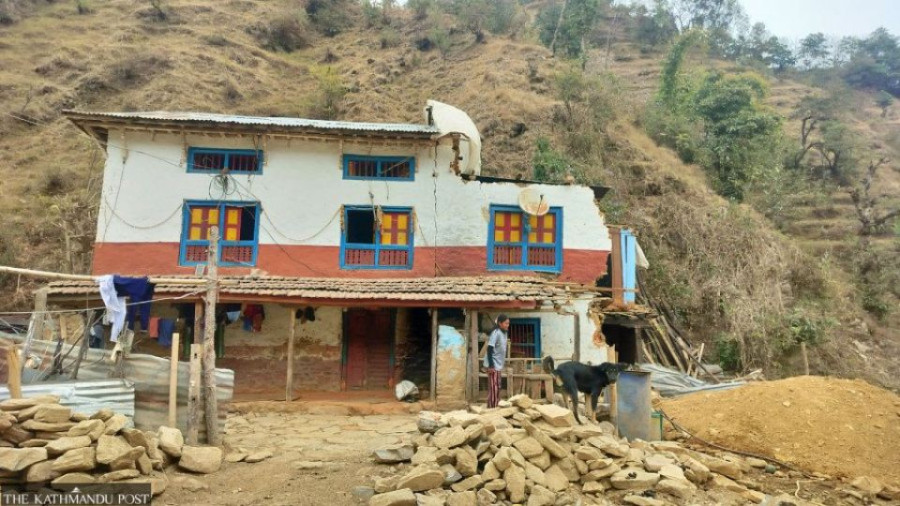Bagmati Province
Kavre’s flood and landslide victims live in limbo a year on
On Sept 27 last year, 79 people died and around 3000 homes were destroyed. Survivors are scattered and struggling to find a safe place to rebuild.
Jyoti Shrestha
It has been a full year since Saraswati Humagain's life changed forever. Living in Kalanti in ward 12 of Panauti Municipality, she has not had a moment without thinking about her only son, Prakash Humagain. On September 27, 2024, heavy rain triggered floods and landslides that destroyed her home, left her homeless, and claimed the life of her 26-year-old son. “Prakash was all I had left,” she says, her voice quiet with grief.
“Since the death of my husband to tuberculosis thirteen years ago, he was my only support. The rain didn’t stop that day; when the place where we lived wasn’t safe, he took me to a safer place in our village, promising he would fetch the aunt who was unwell. After 1 am, his phone didn’t work. I already sensed something was wrong. We clung to hope, but after the flood eased a little at around four, rescuers found two persons alive and two dead—including Prakash.”
Humagain has spent the year not only in mourning but also in turmoil. “Kalanti village is nothing now,” she says, tears welling in her eyes. "We have no house left. I pay Rs2,000 per month for a rented room at Malpi, in ward 8 of Panauti. I have no means to build a new house. The plot of land that is ours is not safe. Every time I ask, they say the location is a landslide risk. I have no money to buy land elsewhere. Even if the government says it will provide relief, where will I build?”
Occasionally, anxiety makes her ill, she adds. Prakash’s fate is shared by many. Kavre, a hill district of Bagmati Province, was among the worst hit by the monsoon disasters in late September last year. According to the authorities, 79 people died, 88 were injured and six others went missing in Kavre alone as a result of floods and landslides, including many in Panauti, Roshi, Temal, Bethanchok and other local units. A total of 2,979 houses were destroyed while some others sustained partial damage. Crops, livestock, roads, bridges and public infrastructure suffered massive losses worth millions of rupees in crop damages alone.
Among those who lost everything is Rajendra Shrestha of Mahabhir in ward 12 of Panauti. His home, shop and fields—all were washed away by the floods. After spending a short time with relatives, he has been renting a room in Banepa for almost a year, paying about Rs15,000 a month.
“With the government’s relief amount, I could not even move to a safer place,” he complained. “Our old site is unsafe—below, flood risk; above, landslide risk. Where else can we go?”
In Bethanchok Rural Municipality, 76-year-old Gopilal Sapkota refuses to abandon his ancestral home, even though one flank of it was crushed by a landslide. “I have patched and propped up what I can; this is still my land, my roots. We had to stay with relatives for a couple of months after the disaster, but we could not keep doing that. So we repaired the house as best as possible and stayed here. The government gave us Rs25,000 for a temporary shelter—that’s just for some makeshift structure, nothing sturdy and durable.”
Many disaster victims have been displaced and compelled to stay elsewhere. The landslide at Walting in ward 10 of Roshi Rural Municipality displaced the entire family of Kanchha Lama. The joint family of 23 members—including Kanchha, his mother, and five brothers with their families—lost their home completely to the disaster. With nowhere to stay in the village, 20 members of the family have now taken shelter in different locations across Kathmandu.

“The landslide left nothing behind in the village—not even a single house or cattle shed,” Kanchha said. “We stayed with relatives for about a month. But when it became clear there was no home left to return to, the whole family moved to Kathmandu. Now, only my mother and two elder brothers remain in the village," said Kanchha.
According to him, the government provided the first instalment of Rs25,000 for rebuilding temporary shelters. With that money, a small hut was built in the village for his mother and two brothers. But Kanchha said the rest of the family could not stay there because of its limited size.
“We don’t have any land in safer locations,” he explained. “Even the place where the hut stands isn’t safe. If heavy rains come again, we might have to flee from there too. Where to live and how to rebuild remain our biggest concerns.” He added that even if the government provides financial assistance for reconstruction, they have no secure land on which to build a permanent house.
Though the government did release the first instalment of Rs25,000 to affected families for the construction of temporary shelters, it failed to ensure that those shelters were built in safe locations. According to records from the district administration, a total of 3,128 households across 13 municipalities in Kavre received Rs78.2 million under the first instalment. Two municipalities went a step further, disbursing the second instalment as well: 196 families in Bethanchok and 461 families in Roshi received the second instalment for temporary housing.
Yet, the larger issue of safety remains unresolved. Data compiled by the District Disaster Management Committee shows that 395 settlements in Kavre were identified as being at high risk following last year’s monsoon-induced disasters. Discussions involving local governments, police units, and the committee concluded that in these 395 settlements of 13 local bodies, 6,375 households with a population of 23,045 people are under the threat of floods and landslides. The risk is highest in Roshi, which has 56 high-risk settlements, while Khanikhola has the fewest, at nine.
While authorities have collected data on the victims and their living conditions, relocating them to safer areas has proven far more difficult. The district disaster management committee decided to request the National Disaster Risk Reduction and Management Authority (NDRRMA) and the Urban Development and Building Office to carry out a detailed geographical study of high-risk settlements. The meeting also decided to instruct all local disaster management committees to identify uninhabitable settlements and recommend relocation plans.
However, eleven months after that decision, no tangible progress has been made. Chief District Officer Umesh Kumar Dhakal, who is also the coordinator of the district disaster management committee, said that repeated requests to higher authorities have gone unanswered. “We have urged the central agencies time and again to act on the relocation plans,” Dhakal said. “But so far, there has been no response and no steps taken toward implementation.”




 7.12°C Kathmandu
7.12°C Kathmandu













